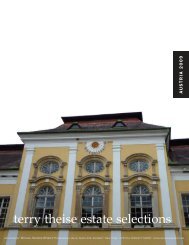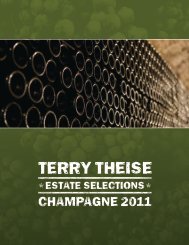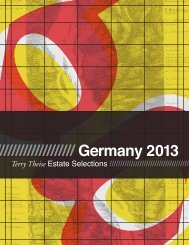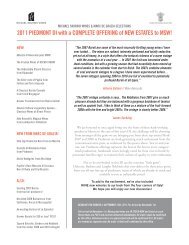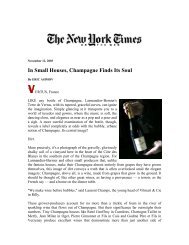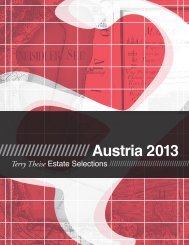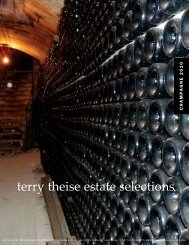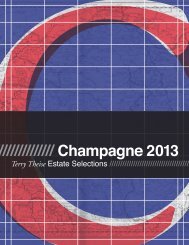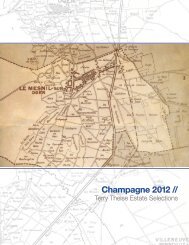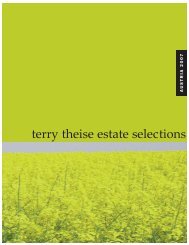German Catalog 2006 USE THIS ONE.qxp - Michael Skurnik Wines
German Catalog 2006 USE THIS ONE.qxp - Michael Skurnik Wines
German Catalog 2006 USE THIS ONE.qxp - Michael Skurnik Wines
You also want an ePaper? Increase the reach of your titles
YUMPU automatically turns print PDFs into web optimized ePapers that Google loves.
impression of remarkable depth and solidity. Their flavors<br />
may fall like little flakes, but they settle like big<br />
snow.<br />
It’s always a challenge to taste here, especially if it’s<br />
the final appointment that day. There are simply too many<br />
great wines. Early in the sequence the palate becomes<br />
alert; it sniffs beauty in the air. Later as you ascend<br />
through realms of richness, the sensitized palate feels as<br />
if its nerve-endings are tingling. Suddenly it isn’t just<br />
wine anymore. It’s as though ALL OF BEAUTY is flooding<br />
into your heart. As you grope for words to convey<br />
this strange experience you find the only words are<br />
mushy, and maybe you feel a little embarrassed. But<br />
don’t. There’s a rigor beneath all that showering loveliness<br />
that you can trust. Beauty is real, and has nothing to<br />
do with sentiment.<br />
“The vineyards, the grapes, play the decisive role in<br />
determining quality,” says Christoffel. “Our vinification<br />
isn’t so different from the norm. We lay high emphasis on<br />
freshness and raciness. At home we drink everything<br />
from dry to sweet, from QbA to Auslese; it only has to be<br />
good! It should be spicy, fruity and lively, with noticeable<br />
acidity. I’d like to think our customers like to return to<br />
our wines after drinking others, and that they feel good<br />
the next morning even if they’ve peered a little too<br />
deeply into the glass the night before!” Christoffel identifies<br />
the section of the Ürziger Würzgarten that lies<br />
among the rocks as his best.<br />
This is a matter of exposure, and of the very old<br />
vines he has planted here. There’s no question that soil<br />
has its own role to play. “The higher the slate proportion,<br />
(therefore more porous) the finer and more elegant the<br />
wines are. Sometimes even too delicate. “What’s ideal is a<br />
slate soil with enough fine-earth to hold water and give<br />
the wines more extract.”<br />
Most of the vineyards are “Würzelecht,” literally<br />
root-genuine, i.e. not grafted onto North American rootstock.<br />
“I have two parcels of grafted wines,” Hans-Leo<br />
told me, “which is two too many!”<br />
THE MATTER OF STARS: the whole star thing came<br />
about because Mosel growers had to find a way of distinguishing<br />
the pecking orders of their various casks of<br />
Auslese. You can’t describe them in terms like “Feine<br />
Auslese” or “Feinste Auslese” any more, and that makes<br />
sense; there are already too many rungs in the quality<br />
ladder. The stars—or any other glyph a grower might<br />
care to employ—are a quasi-legal expedient, and a better<br />
alternative than asking consumers to memorize A.P.<br />
numbers or capsule designs.<br />
For many of us this presents a problem. As soon as<br />
you establish a hierarchy you inadvertently push people<br />
toward the “best,” or the perceived-best. That’s because<br />
we seem to see things from the top down, rather than<br />
from the bottom up. Nobody wants to tell his customers<br />
“I have the second-best cask!” No, you can’t hold your<br />
head up unless you have the big kahoona. It’s a truly shitty<br />
way to look at wine. It has in fact nothing to do with<br />
wine, only with a commodity that happens to be wine.<br />
With Schaefer and Selbach-Oster, the “big three”<br />
christoffel at a glance:<br />
among the Mosels I offer. Everything one can wish<br />
from great wine is lavished on these: depth, clarity, complexity, buoyancy, purity and<br />
ineffable beauty.<br />
Dashingly aromatic, brilliant luster of flavor, inchoate<br />
how the wines taste:<br />
depth which begs for study. The kinds of wines you<br />
keep adding to your notes on; each sip reveals another facet, the second glass differs<br />
from the first, the very last sip is still saying fresh new things. There’s a jewel-like firmness<br />
here; these aren’t leesy or plush. In general, the Erdeners are thicker and more<br />
thrusting; they show better younger. The Ürzigers are refined, fastidious and sleek.<br />
GJC-144 2005 Ürziger Würzgarten Riesling Kabinett<br />
CORE-LIST WINE. In bottle two weeks when I tasted, and it’s bloody difficult if you<br />
want to know the truth. The Auslesen manage OK, they have the density, and another<br />
grower making wines with more stuffing has less to fear from bottle-sickness. But these<br />
very keen silky digital wines just go into a biting tantrum of petulance. The outer surface<br />
of the wine looked spicy, high and glossy, with the expected slatey berried tartness.<br />
But who knows what lies below?<br />
GJC-145 2005 Erdener Treppchen Riesling Kabinett<br />
Used to be the Erdeners showed better early on, but then Flurbereinigung came along<br />
and now all the vines are young. It’s a little fleshier on the palate, and there’s fruit and<br />
length to be discerned. Yo, guys: either bottle the wines in early February or can I please<br />
taste cask-samples?<br />
63<br />
MOSEL WINES



